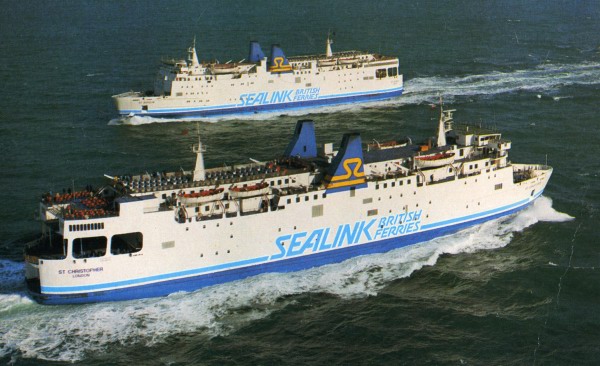The arrival of the Fantasia in 1990 saw the St Anselm transfer to the Folkestone-Boulogne route, but this was to be for only one season and the take-over of Sealink by Stena Line that year saw a major re-appraisal of the entire network. Thus the ship became the Stena Cambria in 1991, reflecting not only the company's new owners but also her new route: Holyhead-Dun Laoghaire, Cambria being one of the traditional names for ships on that crossing. The 'Cambria' remained there, working in tandem with the Stena Hibernia (ex-St Columba) until 1996. By this stage the Sealink name had been dropped in favour of simply “Stena Line” and, with the first HSS due at Holyhead later that year, the Stena Cambria returned to Dover to pad out Stena's local fleet. After the dissolution of the Sealink pool with SNAT, both companies formed independent operations (the French as Seafrance) and Stena felt obliged to replace the crossings previously operated by the two French ships by adding two additional vessels of their own, the former ‘Anselm’ being one of them along with the Stena Empereur (ex-Stena Jutlandica).
The Stena Cambria’s British career ended on and with the Newhaven-Dieppe route; moved there by Stena in February 1997, she transferred to the newly established joint venture with P&O in March 1998. The demise of the Newhaven route in January 1999 saw her laid up briefly in Zeebrugge, before being purchased by UMAFISA of Spain for operations between Barcelona and Ibiza as the Isla de Botafoc. Prior to entering service (in November 1999) the ship underwent a substantial refit to provide additional overnight accommodation for her role on crossings of rather longer length than she had been designed for. The additional cabins were added primarily in the areas aft on Boat Deck previously home to the aft lounges and Duty Free shops whilst significant amounts of reclining seating were installed at the same time in the former Motorists’ Lounge and in an area to port covering what had previously been the Ro-Ro Lounge. UMAFISA were acquired by rivals Balearia in August 2003, and the following Winter the ship was sent for a further extensive refit when, in addition to a major mechanical overhaul, most of the passenger accommodation was refurbished, some of which had not been significantly modified since the Stena days. This had the effect of greatly brightening and improving the ship’s interiors and prepared her for many more years service with her Spanish operators. With Balearia, she continues in operation out of Barcelona, crossing to Ibiza and, latterly, to Menorca. |












